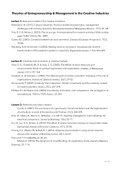Summary
Summary Theories of Entrepreneurship and Management in the Creative Industries, All Materials (passed, 8)
- Course
- Institution
This is all the literature & topics incorporated: Lecture 1: Business models in the creative industries Peltoniemi, M. (2015), Cultural industries: Product–market characteristics, management challenges and industry dynamics. International Journal of Management Reviews, 17(1), 41- 68. Frey...
[Show more]



